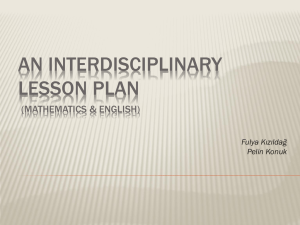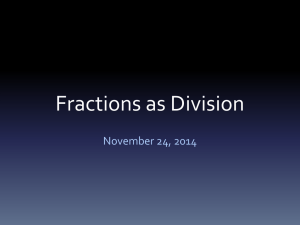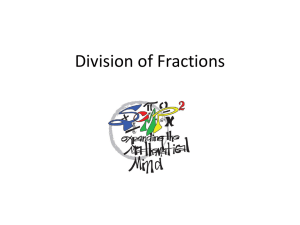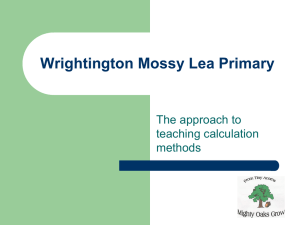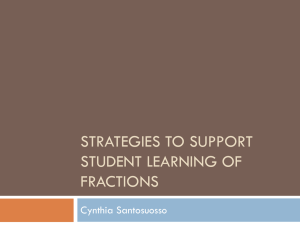Developmental Progression of Rational Number
advertisement
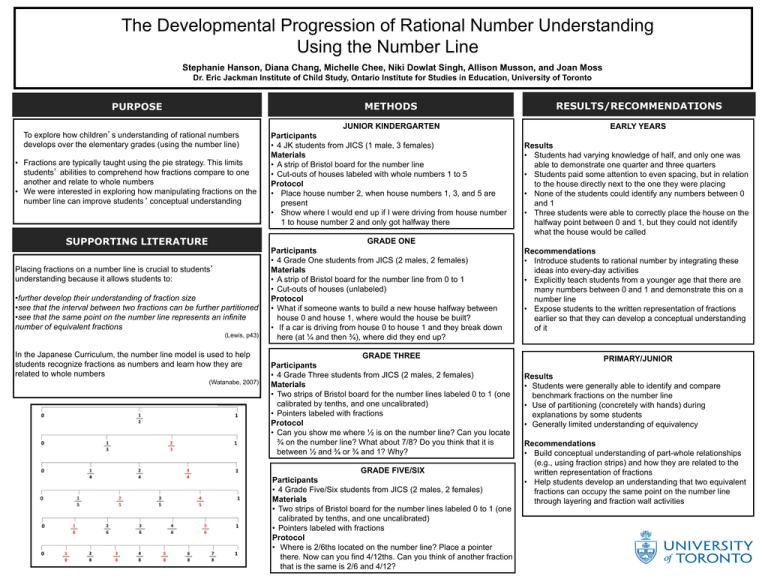
The Developmental Progression of Rational Number Understanding Using the Number Line Stephanie Hanson, Diana Chang, Michelle Chee, Niki Dowlat Singh, Allison Musson, and Joan Moss Dr. Eric Jackman Institute of Child Study, Ontario Institute for Studies in Education, University of Toronto PURPOSE To explore how children’s understanding of rational numbers develops over the elementary grades (using the number line) • Fractions are typically taught using the pie strategy. This limits students’ abilities to comprehend how fractions compare to one another and relate to whole numbers • We were interested in exploring how manipulating fractions on the number line can improve students‘ conceptual understanding SUPPORTING LITERATURE METHODS RESULTS/RECOMMENDATIONS JUNIOR KINDERGARTEN EARLY YEARS Participants • 4 JK students from JICS (1 male, 3 females) Materials • A strip of Bristol board for the number line • Cut-outs of houses labeled with whole numbers 1 to 5 Protocol • Place house number 2, when house numbers 1, 3, and 5 are present • Show where I would end up if I were driving from house number 1 to house number 2 and only got halfway there Results • Students had varying knowledge of half, and only one was able to demonstrate one quarter and three quarters • Students paid some attention to even spacing, but in relation to the house directly next to the one they were placing • None of the students could identify any numbers between 0 and 1 • Three students were able to correctly place the house on the halfway point between 0 and 1, but they could not identify what the house would be called GRADE ONE Placing fractions on a number line is crucial to students’ understanding because it allows students to: •further develop their understanding of fraction size •see that the interval between two fractions can be further partitioned •see that the same point on the number line represents an infinite number of equivalent fractions (Lewis, p43) In the Japanese Curriculum, the number line model is used to help students recognize fractions as numbers and learn how they are related to whole numbers (Watanabe, 2007) Participants • 4 Grade One students from JICS (2 males, 2 females) Materials • A strip of Bristol board for the number line from 0 to 1 • Cut-outs of houses (unlabeled) Protocol • What if someone wants to build a new house halfway between house 0 and house 1, where would the house be built? • If a car is driving from house 0 to house 1 and they break down here (at ¼ and then ¾), where did they end up? GRADE THREE Participants • 4 Grade Three students from JICS (2 males, 2 females) Materials • Two strips of Bristol board for the number lines labeled 0 to 1 (one calibrated by tenths, and one uncalibrated) • Pointers labeled with fractions Protocol • Can you show me where ½ is on the number line? Can you locate ¾ on the number line? What about 7/8? Do you think that it is between ½ and ¾ or ¾ and 1? Why? GRADE FIVE/SIX Participants • 4 Grade Five/Six students from JICS (2 males, 2 females) Materials • Two strips of Bristol board for the number lines labeled 0 to 1 (one calibrated by tenths, and one uncalibrated) • Pointers labeled with fractions Protocol • Where is 2/6ths located on the number line? Place a pointer there. Now can you find 4/12ths. Can you think of another fraction that is the same is 2/6 and 4/12? Recommendations • Introduce students to rational number by integrating these ideas into every-day activities • Explicitly teach students from a younger age that there are many numbers between 0 and 1 and demonstrate this on a number line • Expose students to the written representation of fractions earlier so that they can develop a conceptual understanding of it PRIMARY/JUNIOR Results • Students were generally able to identify and compare benchmark fractions on the number line • Use of partitioning (concretely with hands) during explanations by some students • Generally limited understanding of equivalency Recommendations • Build conceptual understanding of part-whole relationships (e.g., using fraction strips) and how they are related to the written representation of fractions • Help students develop an understanding that two equivalent fractions can occupy the same point on the number line through layering and fraction wall activities




